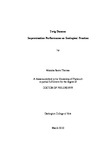Twig Dances: Improvisation Performance as Ecological Practice
| dc.contributor.author | Sarco-Thomas, Malaika | |
| dc.contributor.other | Faculty of Arts, Humanities and Business | en_US |
| dc.date.accessioned | 2012-04-11T16:30:02Z | |
| dc.date.available | 2012-04-11T16:30:02Z | |
| dc.date.issued | 2010 | |
| dc.identifier | 391476 | |
| dc.identifier | Not available | en_US |
| dc.identifier.uri | http://hdl.handle.net/10026.1/936 | |
| dc.description | This is a digitised version of a thesis that was deposited in the University Library. If you are the author and you have a query about this item please contact PEARL Admin (pearladmin@plymouth.ac.uk) | |
| dc.description | Merged with duplicate record (10026.1/892) on 03.01.2017 by CS (TIS) | |
| dc.description.abstract |
ecology by analyzing data collected from a series of experiments in improvisation. Conducted in a number of locations in Europe and Asia, these experiments examine the usefulness of improvisation performance practices to notions of “ecology” and common understandings of humans’ relationships to our environment. Using “ecology” to describe an investigation of interrelationship as well as a commitment to act with an awareness of one’s actions in the social, mental and natural spheres discussed by Felix Guattari (2000), I outline ways contemporary improvisation practices can facilitate this investigation. To do this I draw on my own experience as a dancer at the Performing Arts Research and Training Studios (PARTS) in Brussels from 2004-2006, and as codirector of the TWIG Project in China in 2006. Using the experiences of improvising, learning dance, seeing dance, performing dance, creating scores for dance, and teaching movement improvisation, I argue that ecological practice is defined by its ability to instill a sense of “response ability” and personal agency in its practitioners. As a way of observing and incorporating new knowledge, improvisation functions herein both as a research practice and as the object of study. By improvising and documenting my experiences using a phenomenological lens derived from Merleau-Ponty’s work, I reflect on how practices of awareness in dancing can constitute new ways of knowing. I discuss how improvising can assist awareness of the body’s relationship with the environment at a number of levels including sensory, spatial, temporal, conceptual, social and political. I also investigate the notion of paradox as a theme throughout the thesis and present its usefulness as a way of producing and reflecting upon a practice of bodily research. The term “twig dances” represents an expanded understanding of what I mean by “improvising”, and points to my use of improvisation as a research process. As an action taken “to understand or realize something”, a twig dance is any of a number movement practices which take as their focus an active investigation into relationships between people and the non-human world. | en_US |
| dc.description.sponsorship | Dartington College of Arts | en_US |
| dc.description.sponsorship | The Jack Kent Cooke Foundation; Vitamin Creative Space; Nanling Eco-Tourism, Ltd. | |
| dc.language.iso | en | en_US |
| dc.publisher | University of Plymouth | en_US |
| dc.subject | Ecology | |
| dc.subject | Intercultural performance | |
| dc.subject | Movement | |
| dc.subject | Nature | |
| dc.subject | Embodied imagination | |
| dc.subject | Embodied identification | |
| dc.subject | Transversality | |
| dc.subject | Perception | |
| dc.subject | Performance practice | |
| dc.subject | Improvisation | |
| dc.subject | Dance | |
| dc.subject | Phenomenology | |
| dc.subject | Empathy | |
| dc.subject | Environment | |
| dc.subject | Site | |
| dc.subject | Awareness | |
| dc.subject | Relationship | |
| dc.subject | Intersubjectivity | |
| dc.subject | Paradox | |
| dc.subject | Corporeal phenomenology | |
| dc.subject | Responsibility | |
| dc.title | Twig Dances: Improvisation Performance as Ecological Practice | en_US |
| dc.type | Thesis | |
| dc.identifier.doi | http://dx.doi.org/10.24382/4993 |
Files in this item
This item appears in the following Collection(s)
-
01 Research Theses Main Collection
Research Theses Main



